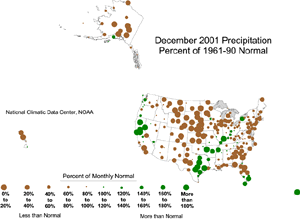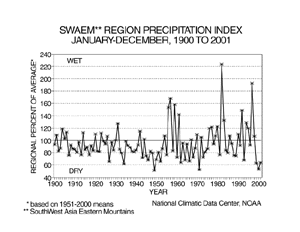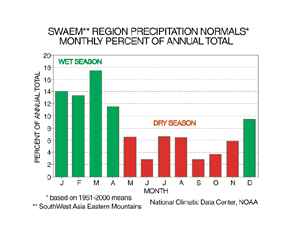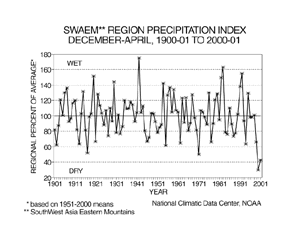U.S. Drought Highlights:
- On the national scale, severe drought affected about 15 percent of the contiguous United States as of the end of December 2001
- Beneficial rain and snow fell over parts of the western U.S. during the last three months, but much of the region continued to suffer from long-term moisture deficits and hydrological impacts of drought
- Drought continued across much of the eastern seaboard and parts of the southern Plains
Contents Of This Report:
National Overview
On the national scale,
|
 larger image |
 larger image |
Although some areas of the U.S. had well above normal precipitation, many areas were very dry. December averaged near normal when precipitation is integrated across the nation. Eleven of the last 29 months have averaged well below the normal, while only three averaged well above normal (see graph to right). National 2001 precipitation ranks:
|
 larger image |
Regional Overview
Beneficial rain and snow during October through December brought an end to short-term drought over much of the western U.S., however long-term drought continued to plague much of the region, especially along the Rocky Mountains. December was dry across parts of the northern Rockies, Gulf Coast, and northern and central Plains. December marked the third consecutive dry month along the eastern seaboard, further intensifying long-term drought conditions. Most of the Alaska stations and the primary stations in northern Hawaii were dry during December. This overall pattern is evident in the following indicators:
|
 |
 |
|
 |
 |
|
|
|
 |
 |
 |
Much of the western rain and snow of the past three months have bypassed Montana. The state has suffered from dry conditions for the last three years, causing many wells to go dry, with 2001 ranking as the eleventh driest year on record statewide. The last five months have been persistently dry, giving the state the fourth driest August-December on record (see graph below left). The December 2001 statewide Palmer Drought Index is nearly as severe as the droughts of the 1930's (see graph below right). In nearby Wyoming, drought has drained reservoirs and stunted shrubs used by deer and antelope for winter forage, putting the wildlife at risk.
 |
|
 |
 |
|
| December brought the third consecutive month of very dry conditions to the east coast. In the Northeast region, 2001 had the second driest October-December on record while it was the third driest for the Southeast. |
 |
 |
| With reservoir storage and ground water supplies well below seasonable averages and, in some cases, at record low levels, the Delaware River Basin Commission declared a drought emergency in mid-December in the 13,539 square-mile watershed which drains portions of New York State, Pennsylvania, New Jersey, and Delaware. |
  |
|
As shown on the Palmer Hydrological Drought Index map to the right, the drought in the east has two epicenters of severity: Maine and South Carolina.
|
 |
  |
|
South Carolina had the driest October-December, August-December, and July-December, and the second driest year on record in 2001, giving rise to a statewide Palmer Drought Index which is comparable in severity to the worst droughts of the last 100 years.
As noted by the state Department of Natural Resources,
|
  |
|

|
| Damage due to the drought has been summarized by NOAA and the Office of Global Programs in the Climatological Impacts section of the Climate Information Project. Crop impact information can be found at the USDA NASS (National Agricultural Statistics Service) and Weekly Weather and Crop Bulletin pages. Drought statements by local National Weather Service Offices can be found at the NWS Hydrologic Information Center. Drought threat assessments and other information can be found at NOAA's Drought Information Center. Additional drought information can be found at the National Drought Mitigation Center, the USDA's National Agricultural Library, the interim National Drought Council, and the NOAA Paleoclimatology Program. The following states have set up web pages detailing current drought conditions and/or their plans to handle drought emergencies:
Delaware - Delaware River Basin (DE-NJ-NY-PA) - Florida Panhandle - Georgia - Hawaii - Idaho - Kentucky - Maryland - Missouri - Montana-1 - Montana-2 - Nebraska - New Jersey - New Mexico - North Carolina - Oklahoma-1 - Oklahoma-2 - Oregon-1 - Oregon-2 - Pennsylvania-1 - Pennsylvania-2 - South Carolina - Texas - Vermont - Washington - Wyoming For additional information on the 2001 wildfire season please see the National Interagency Fire Center web site or the U.S. Forest Service Fire and Aviation web site. NCDC's Drought Recovery Page shows the precipitation required to end or ameliorate droughts and the probability of receiving the required precipitation. Additional climate monitoring graphics can be found at the Climate Prediction Center's monitoring pages: |
SouthWest Asia Eastern Mountains December 2001 Drought
The region in and around the eastern mountains in southwest Asia has been suffering from drought for the last three years. Climate data from this region is frequently unavailable on an operational near-real time basis and historical data is incomplete in many cases, which makes it difficult to compute a regional drought index. To complicate matters, the "normal" climate of the region varies considerably from mountains to plains and the region is generally classified as a desert.
In order to assess the magnitude of the dryness in the southwest Asia eastern mountains region, a precipitation index was created from the precipitation data for ten stations that currently report operationally and that have reasonably complete historical records. The impact of missing data was minimized by using the following methodology. Long-term monthly averages for the twelve months, January - December, for each station were computed over the 1951-2000 period. These 50-year average monthly precipitation values were used as a reference base. The percent of average precipitation for each month and each year in the record for each station was computed using the station's respective monthly base values. These monthly percentages were averaged for the ten stations to produce a seasonal precipitation (i.e., "drought") index for the region.
As seen in the graph below left, the region has experienced below-average precipitation for much of the last three years. The annual precipitation index (graph below right) shows how the dryness compares to the 20th century record. The last three years were very dry by this index, having ranks of fifth driest for 1999, third driest for 2000, and seventh driest for 2001 (out of 102 years).
There is a pronounced seasonality to the precipitation regime, with winters generally being wetter than summers (see graph below left). Here the winter wet season is defined as December through April. The dryness during the last three winter seasons has been even more pronounced (see graph below right), with 1998-99 ranking as the eleventh driest, 1999-2000 as the driest, and 2000-01 as the second driest (out of 101 winters).
During the past few winters, anomalously strong upper level high pressure ridging (associated with sinking air and a lack of precipitation-producing weather systems) centered over the Middle East has severely limited precipitation amounts in the southwest Asia eastern mountains region, resulting in increasing water deficits that have contributed to the severity of the current drought. This circulation regime is also evident in the average annual pattern for the past three years.
 NOAA's National Centers for Environmental Information
NOAA's National Centers for Environmental Information





